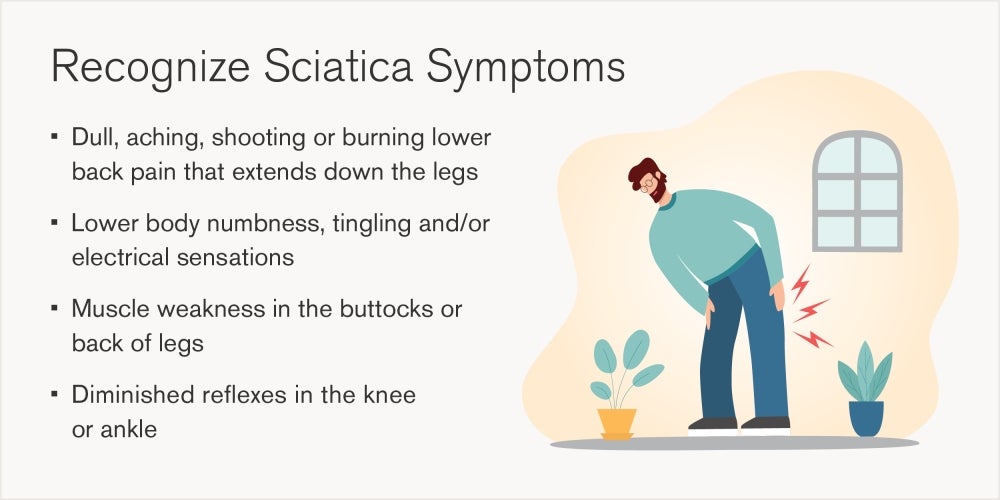What to know about sciatica and how to find relief
October 13, 2025
If you’re feeling pain radiating down your lower back and into your legs, it may be a condition known as sciatica. In the United States, nearly 40% of people will experience the condition in some form and at some time in their lives. If sciatica is affecting your functional mobility and causing increased emotional stress, a number of treatment options are available to help you find lasting relief.
What is sciatica?
The sciatic nerve is the largest and longest nerve in the body, starting at your lower back and running down the back of each leg, ending at your foot. At its thickest point, the nerve is as wide as an adult thumb. Individual nerve roots exit the spinal canal and together form the sciatic nerve. Its primary function is to supply motor functions to each leg and foot, allowing them to move in multiple directions.
“Sciatic nerve pain can come from compression or injury to the nerve as it courses through the leg, but most commonly comes from compression of nerve roots in the spinal canal. That’s when doctors use the general term sciatica,” says Daryn Dass, MD, a neurosurgeon at Loyola Medicine.
Because of the nerve’s large size, a person suffering from sciatica can experience numerous symptoms that can affect the lower back, buttocks, hips or legs.

What causes sciatic nerve pain?
Sciatica is not an injury or disease by itself, but rather a collection of symptoms of a different underlying problem.
Herniated or bulging discs
Spinal discs are shock absorbers that protect the vertebrae of the spine. The discs have a tough outer layer of cartilage that surrounds the softer cartilage in the middle. With age, these discs lose fluid and dehydrate. A bulging disc occurs when part, or all, of the outer layer presses out beyond the edges of the vertebrae. A herniated disc happens when the tough outer layer cracks, allowing some of the inner, softer cartilage to spill out. These two conditions account for most sciatica cases, especially when the herniated disc material compresses a nerve root which can cause sciatic pain or radiculopathy.
“With age, discs can degenerate and joints become overgrown which leads to narrowing of the spinal canal causing spinal stenosis which can lead to a sciatic-type pain,” says Dr. Cass.
Spinal stenosis
The spinal cord ends in individual nerves which travel through the lumbar spine. This tunnel is known as the spinal canal. Spinal stenosis is when the canal narrows, putting pressure on your spinal cord or nerve roots. It can happen anywhere along your spine, but is most common in the lower back, possibly leading to sciatica.
What are the treatment options for sciatica?
Sciatica is usually not a serious or dangerous condition. Many people start with non-surgical options that provide relief, only moving on to surgery if the problem persists. Know that sciatica can be intermittent or persistent. Intermittent pain often responds to home care after a few weeks. If it doesn't improve or is severe or worsening, it is advisable to see a doctor for further treatment.
Non-surgical sciatica treatments
If you’re worried about surgery, know that up to 90% of people who experience sciatica find relief without surgical options, sometimes within a few weeks, although this depends on the person and their level of pain. These non-surgical treatment options can include:
- Physical therapy. Improves flexibility, strengthens core and corrects posture.
- Medications. NSAIDS, oral steroids and nerve medications can help with the pain.
- Lifestyle modifications. Gentle exercise, ergonomic adjustments to your home and weight management can help prevent sciatica in the future.
- Complementary therapies. Acupuncture, heat/cold therapy and other alternative options may help when used alongside traditional methods.
“Epidural steroid injections can also provide relief for patients and help us better understand where the pain is coming from,” says Dr. Cass.
Surgical treatments for sciatica pain relief
Most patients who have sciatica won’t require surgery. However, there are situations in which surgery may be the best solution. If you still have pain after a few weeks of conservative care, have severe leg weakness or numbness or have loss of bladder or bowel control, then it may be time to speak with a doctor about surgical options.
“If conservative management fails, then the recommendation would be to get an MRI to see if there is nerve compression that could be addressed with surgery,” says Dr. Cass.
While every case is different and the type of surgery will depend on the cause of the sciatica, some options are:
- Microdiscectomy. Performed for a herniated disc, this surgery relieves pressure by removing the material causing the pain, namely the small part of the disc material.
- Laminectomy. A surgeon will remove part or all of a vertebral bone to help remove pressure on the spinal cord or nerve roots. This is usually only performed when other medical treatments have not worked.
- Spinal fusion. Reserved for the only the most serious of cases, spinal fusion can be thought of as a welding process, fusing together two or more vertebrae to provide more stability to the spine.
If you’re experiencing severe or persistent pain in your lower back and legs, don’t hesitate to speak with a doctor to learn about your treatment options.

